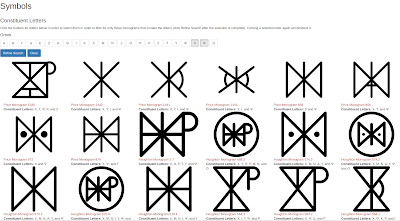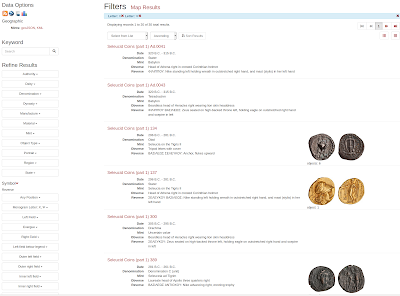Last week, as I begin to transition from the basically-completed Hellenistic Royal Coinages project to publishing the Roman Republican Die Project, I took a few hours to dump a list of names that appear as authorities in the ANS's Greek department and reconcile them against Nomisma.org's API in OpenRefine.
Of the roughly 1,000 names that appear in the Authority facet, about 600 were successfully linked to Nomisma URIs, the majority of which were generated several months ago as a precursor to the launch of the new and improved Coin Hoards database. Of the remaining 400, a relatively small number (several dozen) are names that require further disambiguation between more than one entity (multiple Cotys or Mithridates are represented in the ANS collection) or rulers that have not yet been created in Nomisma. A larger portion of the remaining 400 are Roman magistrates that will be normalized at a later date as we begin to incorporate Roman Provincial Coinage Online URIs into our database or Celtic kings or tribes that will be created in Nomisma in the near future.
The linking of authorities in MANTIS to Nomisma results in a huge improvement in the usability of our Greek coinage. This not only improves that standardization of preferred labels (since we had previously implemented variant names and spellings for the same person in the underlying FileMaker curatorial database), but Nomisma also facilitates the indexing of related dynasty and corporate entity concepts into MANTIS. The Dynasty facet on the browse page is much improved (although not thoroughly cleaned, since we did not eliminate values from this facet for coins not linked to authorities).
More importantly, the State facet now lists all of the overarching corporate entities linked to each individual ruler, satrap, magistrate, etc. This means that for the first time, it is possible to execute a simple query to gather all 1,600 coins of the Parthian Empire, 349 coins of the Kingdom of Elymais, etc. in one result set, rather than relying on the previous dynasty field, which was inconsistently cataloged.
Some further statistics:
There is still much to improve here, both within the Greek department and beyond it, but this is a clear demonstration of the enhancements that can be made in usability by more thorough integration of Linked Open Data identifiers. The effort to achieve this was minimal (since most of the Nomisma IDs had already been created), but is a foundation on which we can build toward better data quality within other departments as we begin to transition from FileMaker to CollectiveAccess as our collections management system.
Of the roughly 1,000 names that appear in the Authority facet, about 600 were successfully linked to Nomisma URIs, the majority of which were generated several months ago as a precursor to the launch of the new and improved Coin Hoards database. Of the remaining 400, a relatively small number (several dozen) are names that require further disambiguation between more than one entity (multiple Cotys or Mithridates are represented in the ANS collection) or rulers that have not yet been created in Nomisma. A larger portion of the remaining 400 are Roman magistrates that will be normalized at a later date as we begin to incorporate Roman Provincial Coinage Online URIs into our database or Celtic kings or tribes that will be created in Nomisma in the near future.
The linking of authorities in MANTIS to Nomisma results in a huge improvement in the usability of our Greek coinage. This not only improves that standardization of preferred labels (since we had previously implemented variant names and spellings for the same person in the underlying FileMaker curatorial database), but Nomisma also facilitates the indexing of related dynasty and corporate entity concepts into MANTIS. The Dynasty facet on the browse page is much improved (although not thoroughly cleaned, since we did not eliminate values from this facet for coins not linked to authorities).
 |
| Parthian coins in MANTIS |
More importantly, the State facet now lists all of the overarching corporate entities linked to each individual ruler, satrap, magistrate, etc. This means that for the first time, it is possible to execute a simple query to gather all 1,600 coins of the Parthian Empire, 349 coins of the Kingdom of Elymais, etc. in one result set, rather than relying on the previous dynasty field, which was inconsistently cataloged.
Some further statistics:
- Of the 94,723 coins in the Greek department, 38,563 are linked to Nomisma URIs for authority.
- 32,177 coins are linked to a Nomisma concept for the related corporate entity. There are 84 corporate entities in total.
There is still much to improve here, both within the Greek department and beyond it, but this is a clear demonstration of the enhancements that can be made in usability by more thorough integration of Linked Open Data identifiers. The effort to achieve this was minimal (since most of the Nomisma IDs had already been created), but is a foundation on which we can build toward better data quality within other departments as we begin to transition from FileMaker to CollectiveAccess as our collections management system.







